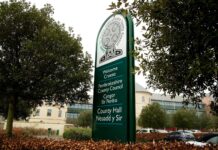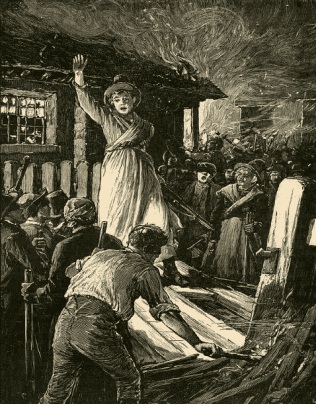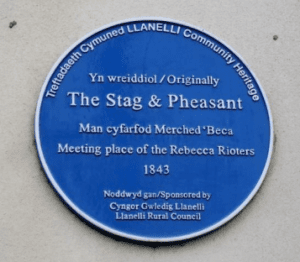The Rebecca Riots
During the middle 19th century, Wales was in deep economic depression. To make matters worse, the population had soared despite the high number of people who had emigrated in search of a new life in far off countries. Employment was suddenly in more demand than ever before and across rural Wales, life was particularly difficult for farmers and agricultural workers who were suffering at the hands of wealthy landowners who were increasing rent and forcing farmers to lease larger farms. And this was only the tip of the iceberg.
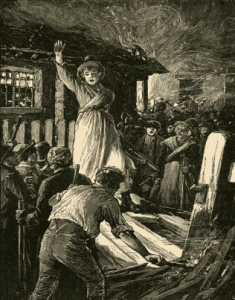
Mounting discontent was also being fuelled by several additional social and economic hardships that were collectively making life unbearable for the poorly paid workers such forced payment of ‘tithes’ to local Anglican parish churches even though at the time, Welsh people in the main were non-conformist (i.e: protestants who disagreed with the doctrine of the of established Church of
England). Added to this, the British Government introduced a ‘Poor Law’ in 1834 which essentially stopped poor able-bodied workers from being paid money to help support them and their families and instead, forced families to live in the appalling workhouses that Charles Dickens often mentioned in books such as Oliver Twist.
But the final straw that broke the camel’s back was the unjustified increases in Toll Gate charges that were erected by rich and powerful landowners on main trading roads throughout rural counties including Carmarthenshire, Pembrokeshire, Cardiganshire and Radnorshire. Many of these landowners served as local magistrates and on ‘Poor Law’ committees which meant they were basically able to determine and enforce their own toll charges, without contention from government.
Eventually, their abuse of rank and privilege and complete lack of empathy for the poor erupted into widespread public outrageand during the four-year period between 1839 and 1843, groups of rioters across Wales took matters into their own hands. Mobs of men dressed in women clothing carried out attacks on toll gates and houses at night and in most instances, burned the buildings to the ground in
remonstration over the unfair charges they were forced to pay. The rioters who organised and carried out such attacks were known as ‘Rebecca’s Daughters’ and it has to be said that despite wanting to cause maximum damage to the toll gates and houses, it was never their intention to harm any toll gate keeper but rather, vent their outrage and anger towards the wealthy landowners who showed such lack of empathy towards the poor working class.
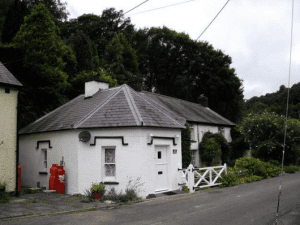
The name Rebecca was believed to have derived from the biblical character Rebekah who is mentioned in the Book of Genesis as being the woman who offered Abraham water from her father’s well. The first Rebecca to lead these riots was Thomas Rees who in May 1839, and supported by a large number of ‘Rebecca’s Daughters’ with blackened and masked faces, attacked the toll house at Yr Efail Wen, in Carmarthenshire. Thomas Rees led no further attack however, his wearing of women clothing as a disguise during his attack was immediately adopted by the thousands of rioters who followed his example.
The toll house at Yr Efail Wen was destroyed but later rebuilt and then only to be destroyed for a second time. It was not rebuilt a third time and contrary to belief, the rioting across Wales did not occur on a regular basis. Often, there would be no rioting for months at a time which proved that by adopting the ‘element of surprise’, unexpected riots achieved maximum damage to toll buildings and the pockets of landowners and indeed, between 1839 and 1842 not one single riot took place in Wales.
In 1842, the toll gate built by Tom Bullin near The Mermaid Tavern at St Clears was attacked after Bullin had been granted permission to establish his own control point. Also attacked in 1842 was the Bolgoed Toll Gate at Pontarddulais by a crowd of over two hundred rioters and two further newly built toll gates were destroyed in Pembrokeshire but instead of military troops being called in to supress the rioters, Marines from West Wales were used in instead.
Secret meetings convened across the country by the Rebecca Daughters to plan and organise attacks and one such place was the Stag and Pheasant near Llanelli as we can see from the blue plaque below. Letters and threats were sent to landlords demanding that they reduce rent charges albeit, all too often, such letters and threats had little effect.
Tragically, a fatality occurred on 7 September, 1843 at the village of Hendy when Sarah Williams, a young gate keeper died after refusing to leave her post despite having been warned that rioters were heading her way. It is recorded that she died after a gun-shot was heard by local folk.
Over time the ‘Rebecca Riots’ turned into peaceful protests and finally stopped after two notorious criminals, John Jones and David Davies from Five Roads in Carmarthenshire, were caught and transported to Australia for carrying out two attacks falsely under the name of the ‘Rebecca’s Daughters’. After much debate by government and at local courts, toll charges across Wales were lowered and, in some cases, no longer enforced and eventually reforms introduced meant that
by 1844, the Rebecca Riots had come to an end.
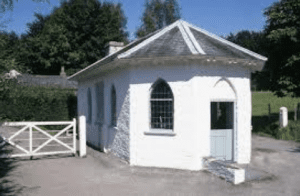
Written by Philip Thomas


















